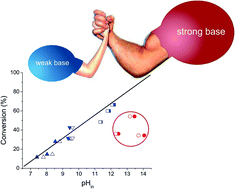Oxidation of benzyl alcohol catalyzed by gold nanoparticles under alkaline conditions: weak vs. strong bases†
Abstract
Gold nanoparticles have shown excellent catalytic properties in selective oxidation of alcohols in the presence of base; however, the influence of the nature and concentration of the base on gold catalyst activity and selectivity is not completely understood. We here present a study of the effect of using weak and strong bases on the conversion and selectivity of PVA-stabilized gold nanoparticles supported on titania (AuPVA/TiO2) for benzyl alcohol oxidation. The increase in the concentration of base had little effect on conversion when a weak base was used (K2CO3, Na2B4O7 and Na(CH3COO)), due to the buffer effect, but strongly affected selectivity. The bases with higher pKa values provided higher conversions and increased production of benzoic acid. For the strong base NaOH, benzoic acid was always the major product, although conversion decreases in excess of base. The formation of benzoic acid is avoided by using K2CO3 in non-aqueous media; benzaldehyde is the main product in cyclohexane whereas benzyl benzoate is also formed in significant amounts in solvent-free conditions. The promotion effect observed in the presence of base was discussed in terms of reaction mechanism.


 Please wait while we load your content...
Please wait while we load your content...